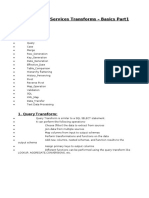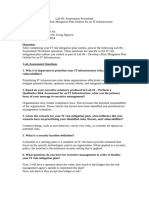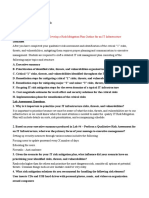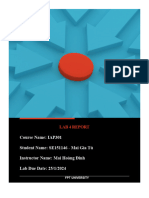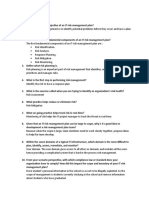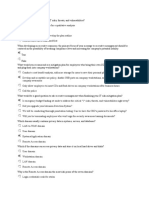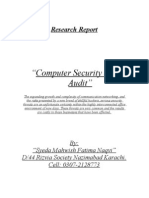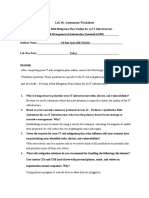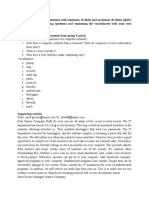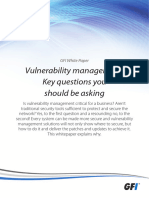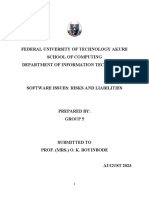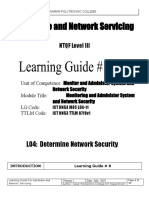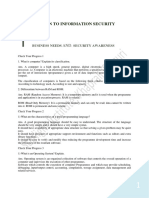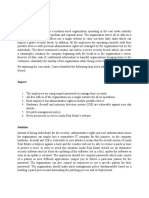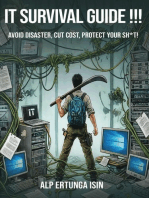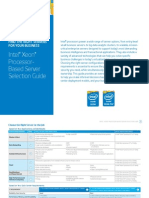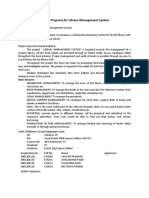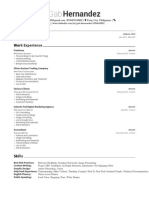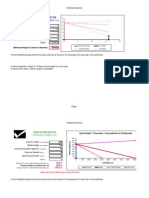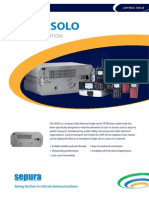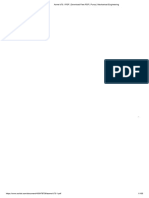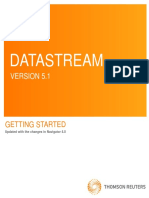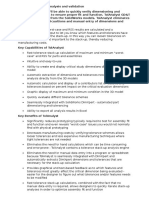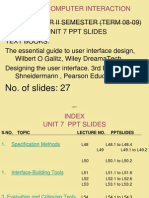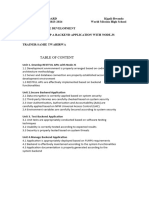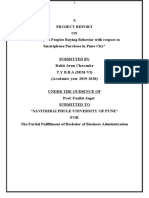0 ratings0% found this document useful (0 votes)
17 viewsLab 6
Lab 6
Uploaded by
Anh DucThis document outlines an assessment worksheet for a student to develop an IT risk mitigation plan. It includes 15 questions about prioritizing risks and threats, communicating priorities to executive management, and distinguishing between short-term and long-term risk mitigation tasks. Key risks identified include users inserting external devices, remote access vulnerabilities, and non-compliance with laws. The student is asked to recommend policies and procedures to incorporate into a long-term risk mitigation plan.
Copyright:
© All Rights Reserved
Available Formats
Download as DOCX, PDF, TXT or read online from Scribd
Lab 6
Lab 6
Uploaded by
Anh Duc0 ratings0% found this document useful (0 votes)
17 views3 pagesThis document outlines an assessment worksheet for a student to develop an IT risk mitigation plan. It includes 15 questions about prioritizing risks and threats, communicating priorities to executive management, and distinguishing between short-term and long-term risk mitigation tasks. Key risks identified include users inserting external devices, remote access vulnerabilities, and non-compliance with laws. The student is asked to recommend policies and procedures to incorporate into a long-term risk mitigation plan.
Original Description:
IAA
Original Title
LAB 6
Copyright
© © All Rights Reserved
Available Formats
DOCX, PDF, TXT or read online from Scribd
Share this document
Did you find this document useful?
Is this content inappropriate?
This document outlines an assessment worksheet for a student to develop an IT risk mitigation plan. It includes 15 questions about prioritizing risks and threats, communicating priorities to executive management, and distinguishing between short-term and long-term risk mitigation tasks. Key risks identified include users inserting external devices, remote access vulnerabilities, and non-compliance with laws. The student is asked to recommend policies and procedures to incorporate into a long-term risk mitigation plan.
Copyright:
© All Rights Reserved
Available Formats
Download as DOCX, PDF, TXT or read online from Scribd
Download as docx, pdf, or txt
0 ratings0% found this document useful (0 votes)
17 views3 pagesLab 6
Lab 6
Uploaded by
Anh DucThis document outlines an assessment worksheet for a student to develop an IT risk mitigation plan. It includes 15 questions about prioritizing risks and threats, communicating priorities to executive management, and distinguishing between short-term and long-term risk mitigation tasks. Key risks identified include users inserting external devices, remote access vulnerabilities, and non-compliance with laws. The student is asked to recommend policies and procedures to incorporate into a long-term risk mitigation plan.
Copyright:
© All Rights Reserved
Available Formats
Download as DOCX, PDF, TXT or read online from Scribd
Download as docx, pdf, or txt
You are on page 1of 3
Lab #6: Assessment Workshee
Develop a Risk Mitigation Plan Outline for an IT Infrastructure
Course Name: IA1708
Student Name: Phạm Công Đức Anh
Instructor Name: He170196
Lab Due Date:23/3/2024
1. Why is it important to prioritize your IT infrastructure risks, threats, and vulnerabilities?
It is important to prioritize because you must be aware of what the risks, threats, and vulnerabilities
there are to your infrastructure. You need this so that you know where the most attention needs to be
focused on.
2. Based on your executive summary produced in Lab #4 Perform a Qualitative Risk Assessment for an
IT
infrastructure, what was the primary focus of your message to executive management?
Setting up security measures through various means includes the following: * Forcing users to update
password every X number of days. * Educating the users. * Firewalls - Anti-malware
3. Given the scenario for your IT risk mitigation plan, what influence did your scenario have on
prioritizing your identified risks, threats, and vulnerabilities?
Common things such as user activity can be a very big risk, so your best bet is to consider all options as
potential threats. You will have to rank some risk higher than the others.
4. What risk mitigation solutions do you recommend for handling the following risk element?
A user inserts a CD or USB hard drive with personal photos, music, and videos on organization owned
computers. A good antivirus program and have all devices scanned as soon as they are plugged in.
Educate employees Disable optical drives/USB ports.
5. What is a security baseline definition?
A "Security Baseline" defines a set of basic security objectives which must be met by any given service
or
system. The objectives are chosen to be pragmatic and complete, and do not impose technical means.
6. What questions do you have for executive management in order to finalize your IT risk
mitigation plan?
How did the executive team become acquainted with cutting-edge risk management
techniques?
Are you utilizing a recognized risk standard or framework to manage risk and uncertainty in
general?
How have you delegated risk management inside your organizations?
7. What is the most important risk mitigation requirement you uncovered and want to communicate to
executive management? In your opinion, why is this the most important risk mitigation requirement?
Evaluating risk relationships and common causes is important since you can't reduce a risk if you don't
know what it is.
8. Based on your IT risk mitigation plan, what is the difference between short-term and long-term
risk mitigation tasks and on-going duties?
Short-term risks are those that can be rectified quickly and will (most likely) have no long-term
consequences for the firm; long-term risks, on the other hand, are those that can result in fines if they
entail compliance concerns. Ongoing chores are the everyday tasks that must be completed in order for
the firm to operate safely.
9. Which of the seven domains of a typical IT infrastructure is easy to implement risk
mitigation solutions but difficult to monitor and track effectiveness?
LAN-to-WAN
10. Which of the seven domains of a typical IT infrastructure usually contains privacy data
within systems, servers, and databases?
Application
11. Which of the seven domains of a typical IT infrastructure can access privacy data and also store it
on local hard drives and disks?
Workstation
12. Why is the Remote Access Domain the most risk prone of all within a typical IT infrastructure?
Because it enables people to access to the intranet from afar. Users can connect to network resources
with ease. If the remote access server is a dial-in server, users can connect by dialing in. You can also
utilize a virtual private network (VPN) (VPN). A VPN enables users to connect to a private network over
a
public network such as the internet. You must, however, reduce the danger of an attacker gaining
unauthorized access to the same resources. Users who work from home computers or mobile devices
such as laptops while on the job may drastically enhance their productivity and flexibility using remote
access solutions.
13. When considering the implementation of software updates, software patches, and software fixes,
why must you test this upgrade or software patch before you implement this as a risk mitigation tactic?
To ensure that there are no harmful elements, such as viruses, that might propagate to other systems
14. Are risk mitigation policies, standards, procedures, and guidelines needed as part of your longterm
risk mitigation plan? Why or why not?
Yes, so no, everything is done in a certain order to ensure completion and accuracy.
15. If an organization under a compliance law is not in compliance, how critical is it for
your organization to mitigate this non-compliance risk element?
It is critical for a company to understand which laws apply to them. Once these have been discovered, it
is critical to guarantee that the company is compliant. Noncompliance might have serious ramifications.
Some laws impose significant fines on organizations. Other laws may result in incarceration. Some can
have a detrimental impact on an organization's capacity to do business. For example, HIPAA violations
can result in fines of up to $25,000 per year. An internal compliance program can help to prevent these
costly blunders.
You might also like
- Case Study CyberDocument6 pagesCase Study CyberMuhammad Sardaar100% (2)
- Chrome Devtools Cheatsheet PDFDocument13 pagesChrome Devtools Cheatsheet PDFChastityNo ratings yet
- Assessment Worksheet Develop A Risk Mitigation Plan Outline For An It InfrastructureDocument4 pagesAssessment Worksheet Develop A Risk Mitigation Plan Outline For An It InfrastructureHờ Bờ Lờ100% (1)
- Lab #5 - Assessment Worksheet Elements of a Security Awareness & Training Policy Student Name: Vũ Tuấn Anh Student ID: SE130255Document5 pagesLab #5 - Assessment Worksheet Elements of a Security Awareness & Training Policy Student Name: Vũ Tuấn Anh Student ID: SE130255U MinhNo ratings yet
- Lab #3 - Assessment Worksheet: A. Healthcare Provider Under HIPPA Compliance LawDocument5 pagesLab #3 - Assessment Worksheet: A. Healthcare Provider Under HIPPA Compliance LawDuong Chi Hung (K15 HCM)No ratings yet
- Information Systems Security: Shanghai Wireless CafeDocument12 pagesInformation Systems Security: Shanghai Wireless CafeKarina Ayu100% (2)
- 98-367 Instructor GuideDocument44 pages98-367 Instructor Guidesatya2885% (26)
- Lab #4 - Assessment Worksheet Craft A Layered Security Management Policy - Separation of Duties ABC Credit Union Policy Name+ Policy StatementDocument4 pagesLab #4 - Assessment Worksheet Craft A Layered Security Management Policy - Separation of Duties ABC Credit Union Policy Name+ Policy StatementVo Minh Khanh (K14 HCM)No ratings yet
- SAP BO Data Services TransformsDocument27 pagesSAP BO Data Services TransformsLakshmi P100% (1)
- FusionSphere V100R005C10U1 Software Installation Guide (Server Virtualization) 01Document150 pagesFusionSphere V100R005C10U1 Software Installation Guide (Server Virtualization) 01ABDEL PAGNA KARIMNo ratings yet
- IA1802-IAA202-Lab6-Nguyễn Trọng Dũng-HE172688Document4 pagesIA1802-IAA202-Lab6-Nguyễn Trọng Dũng-HE172688dungnthe172688No ratings yet
- Lab #6: Assessment Worksheet Develop A Risk Mitigation Plan Outline For An IT InfrastructureDocument4 pagesLab #6: Assessment Worksheet Develop A Risk Mitigation Plan Outline For An IT InfrastructureBí RẩyNo ratings yet
- IAA202 IA1804 Lab6 NguyenDinhLongVu HE173399Document6 pagesIAA202 IA1804 Lab6 NguyenDinhLongVu HE173399Nguyễn Đình Long Vũ K17HLNo ratings yet
- Lab #6: Assessment Worksheet Develop a Risk Mitigation Plan Outline for an IT Infrastructure Course Name: IAA202 Student Name: Dương Chí Hùng Instructor Name: Nguyễn Tấn Danh Lab Due Date: 25/6/2021Document5 pagesLab #6: Assessment Worksheet Develop a Risk Mitigation Plan Outline for an IT Infrastructure Course Name: IAA202 Student Name: Dương Chí Hùng Instructor Name: Nguyễn Tấn Danh Lab Due Date: 25/6/2021Duong Chi Hung (K15 HCM)No ratings yet
- Lab 6Document3 pagesLab 6hovietan2003No ratings yet
- Lab #6: Assessment Worksheet Develop A Risk Mitigation Plan Outline For An IT InfrastructureDocument3 pagesLab #6: Assessment Worksheet Develop A Risk Mitigation Plan Outline For An IT InfrastructureCông ĐạiNo ratings yet
- Iaa202 - Lab6 - Ia1803 - Le Tien Long - He171603Document7 pagesIaa202 - Lab6 - Ia1803 - Le Tien Long - He171603Le Tien LongNo ratings yet
- Lab3 IAA202Document2 pagesLab3 IAA202phonghoang092003No ratings yet
- Lab 4Document11 pagesLab 4khoa20033002No ratings yet
- LAB4Document6 pagesLAB4Nguyen An Ninh K15 HCMNo ratings yet
- IAA Lab3 HuynhMinhHaDocument2 pagesIAA Lab3 HuynhMinhHaHuynh Minh Ha (K16HCM)No ratings yet
- QuizzzDocument2 pagesQuizzzAVINNNNASHNo ratings yet
- Is3110 Lab 1 How To Identify Threats Vulnerabilities in An It InfrastructureDocument7 pagesIs3110 Lab 1 How To Identify Threats Vulnerabilities in An It InfrastructuressssssssssNo ratings yet
- Lab 6Document5 pagesLab 6tu03xlyNo ratings yet
- 11 Top Cyber Security Best Practices To Prevent A BreachDocument3 pages11 Top Cyber Security Best Practices To Prevent A BreachArmena BegradoNo ratings yet
- Thesis - Computer-Security-Audit PDFDocument34 pagesThesis - Computer-Security-Audit PDFLoverianNo ratings yet
- Case 3Document7 pagesCase 3Chandru ChandruNo ratings yet
- Chapter 7Document10 pagesChapter 7minichelagumas143No ratings yet
- Lab2 Iaa202Document3 pagesLab2 Iaa202phonghthe173266No ratings yet
- Top 30 Endpoint Security Interview Questions and Answers - Craw SecurityDocument11 pagesTop 30 Endpoint Security Interview Questions and Answers - Craw SecurityjajamsrinuNo ratings yet
- Case Study2Document5 pagesCase Study2Chandru ChandruNo ratings yet
- Lab #3 - Assessment Worksheet: Risk - Threat - VulnerabilityDocument4 pagesLab #3 - Assessment Worksheet: Risk - Threat - VulnerabilityNguyen Viet Quang Vu (K15 HCM)No ratings yet
- Lab 6Document2 pagesLab 6Quy VuNo ratings yet
- Cybersecurity 2024Document3 pagesCybersecurity 2024korodemichael81No ratings yet
- IT FP2250 KellyTravis Assessment6 1Document6 pagesIT FP2250 KellyTravis Assessment6 1Anas ToufeeqNo ratings yet
- Lab 1Document6 pagesLab 1Nguyễn Thành Đạt (Nguyễn Thành Đạt)No ratings yet
- Iaa 2Document7 pagesIaa 2naNo ratings yet
- Lab3 - Information Systems Security Policy FWDocument5 pagesLab3 - Information Systems Security Policy FWS Teja Svi0% (2)
- Unit 1Document265 pagesUnit 1arundhatiNo ratings yet
- Network Security NotesDocument7 pagesNetwork Security NotesAKIRA HarashiNo ratings yet
- Pecha KuchaDocument3 pagesPecha KuchaYuda BacasNo ratings yet
- Iaa 3Document3 pagesIaa 3naNo ratings yet
- It Securiyt Ass 2 FinzlDocument90 pagesIt Securiyt Ass 2 FinzlBehailu DemissieNo ratings yet
- Mis SolutionsDocument10 pagesMis SolutionscsturksonNo ratings yet
- Auditing in CIS Environment DISCUSSION 13Document7 pagesAuditing in CIS Environment DISCUSSION 13Yo Han SongNo ratings yet
- Lab2 (IAA202 IA1809 SE184732 NguyenHoangQuan)Document9 pagesLab2 (IAA202 IA1809 SE184732 NguyenHoangQuan)quannhse184732No ratings yet
- CFSS Internship Soc AnalystDocument34 pagesCFSS Internship Soc Analystrohithvel100% (1)
- Lab6 Iaa202Document7 pagesLab6 Iaa202phonghthe173266No ratings yet
- How To Conduct Security AuditDocument7 pagesHow To Conduct Security Auditronics123No ratings yet
- FINAL Information Security Questions and Some Answers Webinar PDFDocument25 pagesFINAL Information Security Questions and Some Answers Webinar PDFJaneNo ratings yet
- Security PolicyDocument26 pagesSecurity PolicySally Frederick TudorNo ratings yet
- Global FinanceDocument12 pagesGlobal FinanceGeorge SmithNo ratings yet
- Vulnerability ManagementDocument7 pagesVulnerability ManagementKumari RangabashyamNo ratings yet
- Ift 507 Group 5Document28 pagesIft 507 Group 5baddest adebayorNo ratings yet
- Hardware and Network Servicing: LO4: Determine Network SecurityDocument17 pagesHardware and Network Servicing: LO4: Determine Network SecuritySami NurNo ratings yet
- Information Security CourseworkDocument6 pagesInformation Security Courseworkbdg8b37x100% (2)
- Msei-021 Q&aDocument26 pagesMsei-021 Q&ashiv pandeyNo ratings yet
- IAA202 Lab2 SE140810Document3 pagesIAA202 Lab2 SE140810Vinh Huynh K14 HCMNo ratings yet
- Network SecurityDocument10 pagesNetwork SecurityRyu GarimNo ratings yet
- Student Assessment Tasks 520 FinalDocument23 pagesStudent Assessment Tasks 520 FinalYayo MirandaNo ratings yet
- Certified Cybersecurity Compliance ProfessionalFrom EverandCertified Cybersecurity Compliance ProfessionalRating: 5 out of 5 stars5/5 (5)
- IT Survival Guide !!!: Avoid Disaster, Cut Cost, Protect Your Sh*t!From EverandIT Survival Guide !!!: Avoid Disaster, Cut Cost, Protect Your Sh*t!No ratings yet
- Xeon Intel Server Processor Comparison GuideDocument11 pagesXeon Intel Server Processor Comparison GuidepekawwNo ratings yet
- Project Proposal For Library Management PDFDocument1 pageProject Proposal For Library Management PDFKing204No ratings yet
- Gab Hernandez Freelance Resume PDFDocument2 pagesGab Hernandez Freelance Resume PDFGabriel HernandezNo ratings yet
- Torres Enfr EvapcoDocument98 pagesTorres Enfr Evapcolaherrans100% (1)
- Quick Predict Antenna ToolDocument9 pagesQuick Predict Antenna ToolAndré RibeiroNo ratings yet
- Footfall Verification ExampleDocument6 pagesFootfall Verification ExampleAdrian Diez0% (1)
- 0019 0215 v11 Datasheet Tetra Extras Solo English LRDocument2 pages0019 0215 v11 Datasheet Tetra Extras Solo English LRlda2000No ratings yet
- Mega Net Impress Catalog eDocument2 pagesMega Net Impress Catalog eka_ridwanNo ratings yet
- Lakepro-1 Manual Vtronix Editionv5 11-10-2021 EnglishDocument106 pagesLakepro-1 Manual Vtronix Editionv5 11-10-2021 EnglishDanielNo ratings yet
- OLANTIGUE Written ReportDocument15 pagesOLANTIGUE Written ReportJessie OlantigueNo ratings yet
- Asme b73.1 PDF - Download Free PDF - Pump - Mechanical EngineeringDocument100 pagesAsme b73.1 PDF - Download Free PDF - Pump - Mechanical Engineeringsanyogsalvi5No ratings yet
- Mean Median ModeDocument5 pagesMean Median ModeAzeem AltafNo ratings yet
- Javascript Unit IIIDocument16 pagesJavascript Unit IIIAkash PawarNo ratings yet
- Performance AnalysisDocument32 pagesPerformance AnalysismathuNo ratings yet
- Ecb - Dedocs230113 Annex 1 Digital Euro Market Research - enDocument74 pagesEcb - Dedocs230113 Annex 1 Digital Euro Market Research - enFigurativnoFiktivanNo ratings yet
- Chapter 4 OperatorsDocument25 pagesChapter 4 Operatorswaleed albashaNo ratings yet
- Datastream 5.1 User GuideDocument97 pagesDatastream 5.1 User GuideVu H ThanhNo ratings yet
- Unit 1 - Exploring - 10 BlocksDocument3 pagesUnit 1 - Exploring - 10 BlocksTúNo ratings yet
- Tolerance StackDocument2 pagesTolerance Stackbrpnaidu2157No ratings yet
- Mapeh 10 Q2 Reviewer (Arts)Document8 pagesMapeh 10 Q2 Reviewer (Arts)Keissha Junnice DimaandalNo ratings yet
- Creating A Connection: ImportsDocument4 pagesCreating A Connection: ImportsMythes JicaNo ratings yet
- Human Computer Interface - Unit 7Document27 pagesHuman Computer Interface - Unit 7Anik67% (3)
- IWO Work Order Ref No. 17-043018: Requestor DetailsDocument2 pagesIWO Work Order Ref No. 17-043018: Requestor DetailsBenjamin MedinaNo ratings yet
- TL DCX Samples V4.20Document13 pagesTL DCX Samples V4.20Miguel ReyesNo ratings yet
- Develop A Backend Application With Node - JsDocument26 pagesDevelop A Backend Application With Node - Jsgudonion0% (1)
- Shakers - CatalogDocument8 pagesShakers - Catalogdéborah_rosales100% (1)
- Sample Project For BbaDocument53 pagesSample Project For BbaMahir BhatiaNo ratings yet








